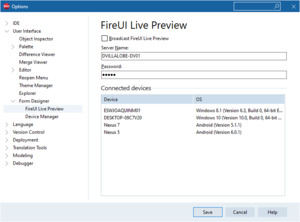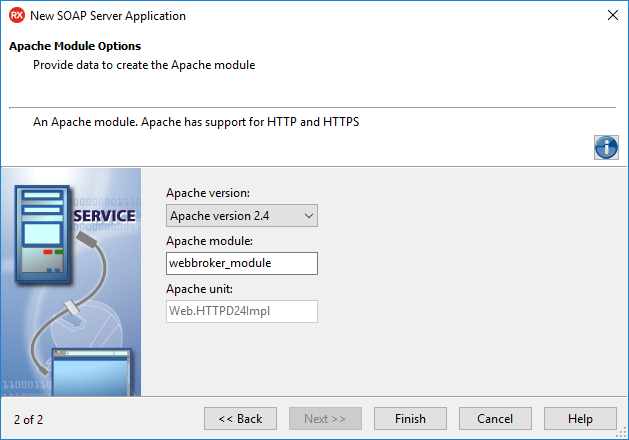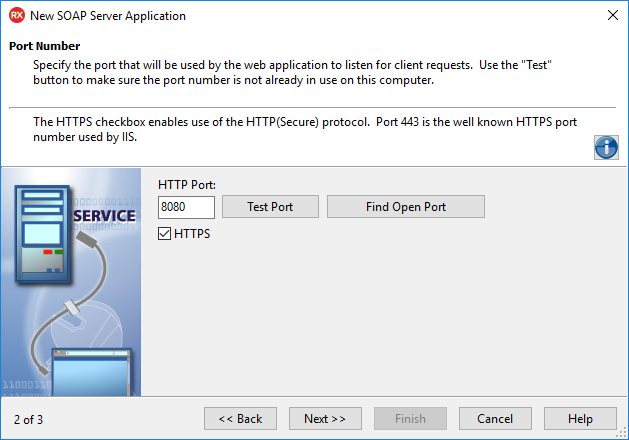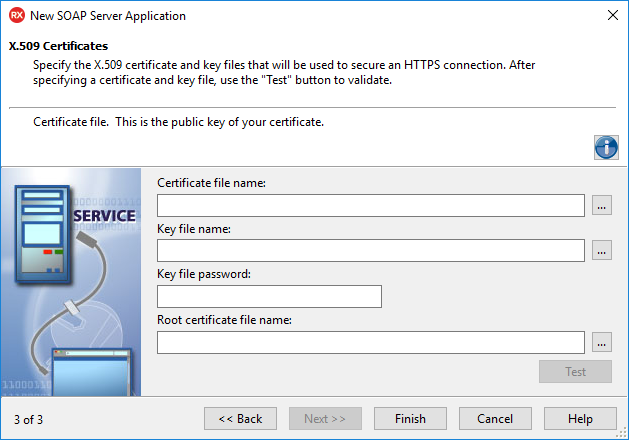New SOAP Server Application
Go Up to File Menu
File > New > Other > Delphi Projects > Web Services > SOAP Server Application
Use this wizard to create and specify the type of server your SOAP Service application will work with.
Contents
WebBroker Project Type page
On this page, select the type of your WebBroker project.
- 1. Select the needed type of the WebBroker Project:
- Apache dynamic link module: a server that hosts static or dynamic websites, providing secure and efficient web server features as CGI (Common Gateway Interface), SSL (Secure Sockets Layer), and virtual domains. Apache supports HTTP and HTTPS.
- Stand-alone console application: a stand-alone Web Server console application is a web server that has a text-only user interface. It supports HTTP by using an Indy HTTP server component (TIdHTTPServer).
- Stand-alone application: a web server that displays a form. It supports HTTP by using an Indy HTTP server component.
- ISAPI dynamic link library: ISAPI Web server applications are shared objects that are loaded by the Web server. Client request information is passed to the DLL as a structure and evaluated by TISAPIApplication. Each request message is handled in a separate execution thread. Selecting this type of application adds the library header of the project files and required entries to the uses list and exports clause of the project file.
- CGI stand-alone executable: a Web server application is a console application that receives client request information on standard input and passes the results back to the server on standard output. This data is evaluated by TCGIApplication. Each request message is handled by a separate instance of the application. In Delphi, selecting this type of application adds the required entries to the uses clause of the project file and adds the appropriate $APPTYPE directive to the source.
- 2. Click Next.
Apache Module Options page
This page opens only if you selected the Apache dynamic link module on the WebBroker Project Type page. On this page, enter the data required to create the Apache module. Specify the following:
- Apache version: select the needed version.
- Apache module: select the needed module.
- Apache unit: this value is predefined, so you cannot edit it.
- Click Finish.
Port Number page
This page opens only if you selected Stand-alone console application on the WebBroker Project Type page. On this page, specify the ports that the SOAP Server Application will use to listen to the client requests.
- To check the availability of the specified port, click Test Port.
- To select an open port automatically detected by the DataSnap Server, click Find Open Port.
- Click Next.
- Note: Select the HTTPS check box to use the HTTPS protocol. The HTTPS communications port will be set to 443, which is a commonly used port by IIS, and the wizard will display an additional step that prompts for information regarding the X.509 certificate files.
X.509 Certificates
This step appears only if you selected the HTTPS communication protocol on the Port Number page. To use the X.509 certificates:
- 1. Enter the following data:
- Certificate file name: holds the X.509 certificate (*.pem).
- Key file name: holds the key.
- Key file password: contains the password for the key file.
- Root certificate file name: holds the root certificate.
- 2. To validate the selection, click Test.
- 3. Click Finish.
Application Type page
This page opens only if you selected the Stand-alone application option on the WebBroker Project Type page. To select the type of the Stand-alone application:
- 1. Click the needed type of application:
- 2. Click Next.




